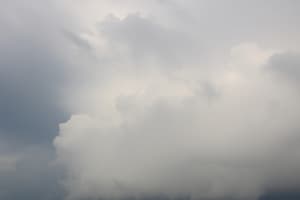Podcast
Questions and Answers
What atmospheric condition primarily initiates the formation of thunderstorms?
What atmospheric condition primarily initiates the formation of thunderstorms?
- Quick upward movements of warm, moist air. (correct)
- Slow, downward movements of cool, dry air.
- The presence of a stable, high-pressure system.
- Horizontal movement of cold, dense air masses.
Which of the following sequences correctly describes the life cycle stages of a thunderstorm?
Which of the following sequences correctly describes the life cycle stages of a thunderstorm?
- Developing, Dissipating, Mature.
- Developing, Mature, Dissipating. (correct)
- Dissipating, Mature, Developing.
- Mature, Developing, Dissipating.
How does a downdraft contribute to the overall structure and lifecycle of a thunderstorm?
How does a downdraft contribute to the overall structure and lifecycle of a thunderstorm?
- It inhibits precipitation formation, leading to weaker storms.
- It is formed by falling precipitation, dragging cooler air downwards, and contributes to storm cell development. (correct)
- It supplies warm, moist air to fuel the storm's updraft.
- It cuts off the storm's energy source by preventing condensation.
Under what conditions is a thunderstorm classified as 'severe'?
Under what conditions is a thunderstorm classified as 'severe'?
Why is lightning seen before thunder is heard during a thunderstorm?
Why is lightning seen before thunder is heard during a thunderstorm?
How do multi-cell thunderstorms differ from single-cell thunderstorms in terms of duration and intensity?
How do multi-cell thunderstorms differ from single-cell thunderstorms in terms of duration and intensity?
What is the primary mechanism by which a mesoscale convective vortex can contribute to the formation of a new thunderstorm or even a tropical cyclone?
What is the primary mechanism by which a mesoscale convective vortex can contribute to the formation of a new thunderstorm or even a tropical cyclone?
Which atmospheric condition is LEAST likely to contribute directly to the formation of a thunderstorm?
Which atmospheric condition is LEAST likely to contribute directly to the formation of a thunderstorm?
How does the collision of ice particles in a cumulonimbus cloud contribute to the development of a thunderstorm?
How does the collision of ice particles in a cumulonimbus cloud contribute to the development of a thunderstorm?
What role does convection play in the formation of thunderstorms?
What role does convection play in the formation of thunderstorms?
A meteorologist observes a towering cumulonimbus cloud with a dark base and a flattened top (anvil shape). What weather phenomenon is MOST likely imminent?
A meteorologist observes a towering cumulonimbus cloud with a dark base and a flattened top (anvil shape). What weather phenomenon is MOST likely imminent?
If the number of thunderstorms that reach severe levels is about 10% of all thunderstorms in the US, and there are about 100,000 thunderstorms each year, about how many thunderstorms reach severe levels?
If the number of thunderstorms that reach severe levels is about 10% of all thunderstorms in the US, and there are about 100,000 thunderstorms each year, about how many thunderstorms reach severe levels?
A parcel of air rises rapidly through the atmosphere. What process is LEAST likely to occur as it ascends?
A parcel of air rises rapidly through the atmosphere. What process is LEAST likely to occur as it ascends?
Which of the following statements BEST describes the relationship between thunderstorms, tornadoes, and hurricanes?
Which of the following statements BEST describes the relationship between thunderstorms, tornadoes, and hurricanes?
How does the geographical location relate to the frequency of thunderstorms?
How does the geographical location relate to the frequency of thunderstorms?
Flashcards
What is a Thunderstorm?
What is a Thunderstorm?
A storm characterized by the presence of thunder and lightning.
Where do Thunderstorms happen?
Where do Thunderstorms happen?
Tall, dark clouds, known as cumulonimbus clouds, are where thunderstorms happen.
Updraft
Updraft
Warm, moist air rises rapidly into the atmosphere.
Needed for Thunderstorm Formation
Needed for Thunderstorm Formation
Signup and view all the flashcards
Convection
Convection
Signup and view all the flashcards
Condensation
Condensation
Signup and view all the flashcards
Convection Cell
Convection Cell
Signup and view all the flashcards
Cumulonimbus Cloud?
Cumulonimbus Cloud?
Signup and view all the flashcards
Storm Formation
Storm Formation
Signup and view all the flashcards
Developing Stage
Developing Stage
Signup and view all the flashcards
Mature Stage
Mature Stage
Signup and view all the flashcards
Dissipating Stage
Dissipating Stage
Signup and view all the flashcards
Single-Cell Storms
Single-Cell Storms
Signup and view all the flashcards
Supercells
Supercells
Signup and view all the flashcards
Mesoscale Convective System
Mesoscale Convective System
Signup and view all the flashcards
Study Notes
- Storms are atmospheric disturbances, while thunderstorms are storms specifically with thunder and lightning
- Thunderstorms can occur almost anywhere, and severe ones can lead to tornadoes and hurricanes
- Most thunderstorms move with the wind flow in the troposphere
- Worldwide, there are about 16 million thunderstorms annually
- The United States experiences around 100,000 thunderstorms each year, with about 10% reaching severe levels
Thunderstorm Description
- Thunderstorms occur in cumulonimbus clouds, which are tall and dark
- These storms typically have strong winds and precipitation (rain, sleet, hail, snow), but sometimes have no precipitation
- An updraft causes thunderstorms, which happens when warm, moist air rises and mixes into the atmosphere
- Frequent thunderstorms form where warm air from tropical areas and cooler air from polar regions meet
Thunderstorm Formation
- Thunderstorm formation requires moisture, unstable air, and a lifting force (heat)
- The sun heats the Earth's surface, warming the air above it and causing it to rise
- Convection is the transfer of heat from the Earth's surface to the upper atmosphere
- Water vapor in the air cools, leading to condensation and the formation of cumulus clouds, and cooled air drops
- Convection cell is the cycling of rising and falling air, which is considered unstable air
- Typical thunderstorms can reach 33,000 feet, with some exceeding 66,000 feet in altitude
- Tall clouds darken and become cumulonimbus clouds
- Ice particles collide in the cloud, causing electricity to build up which causes a bolt of lightning
- Thunder is the sound waves created by lightning
Storm Formation
- Storms form due to quick upward movement of warm, moist air with a force pushing it upward
- A trough, which is a long low-pressure system, can push the cloud upwards
- As warm air rises, it cools, condenses, and forms a cumulonimbus cloud, potentially reaching over 12 miles high
- Downdrafts are cool air sinking, created by falling water droplets dragging cooler air
- The combination of warm updrafts and cool downdrafts creates a storm cell
- The process repeats until the air temperature is equalized and an anvil shape forms creating anvil head/thunderstorm clouds
Thunderstorm Life Cycle
- Thunderstorms go through three stages: developing, mature, and dissipating
The Developing Stage:
- A cumulus cloud is pushed upward by an updraft
- The cumulus cloud grows in height
- This stage has little to no precipitation but there may be lightning
The Mature Stage:
- In this stage, precipitation begins to fall out of the storm, creating a downdraft
- As the downdraft spreads, wind speed increases
- Heavy rain, hail, lightning, and tornadoes can occur
- Precipitation eventually overcomes the updraft, leading the storm to dissipate
The Dissipating Stage:
- A front forces the storm to break up, cutting off the warm, moist air supply
- Precipitation decreases, and the storm dissipates
Types of Thunderstorms
Single Cells
- Small, weak, and brief (typically lasting about an hour)
- Driven by hot temperatures on a summer afternoon
- Can contain heavy rain and lightning
- Often called "popcorn" storms
Multi-Cell Clusters
- Groups of storm cells spread out, forming from new updrafts along the edge of rain-cooled air (gust front)
- Pass through an area in 30 to 60 minutes, but can last for hours
- Can produce hail, strong winds, brief tornadoes, and flooding
Multi-Cell Lines
- Arranged in a line with high winds and heavy rain, also called a squall line
- A squall is a sudden burst of violent wind
- Pass through quickly due to their long, narrow shape
- Less likely to produce tornadoes
Supercells
- Long-lasting, organized storms that can last over an hour long
- Gaining power by an updraft that is tilted and rotating and can rotate for around 20-60 minutes
- Large and violent tornadoes can form from supercells
Severe Thunderstorms
- Classified as "severe" if containing: hail one inch or greater, winds exceeding 58 mph, or a tornado
- Can occur from any type of storm cell
Mesoscale Convection
- A system is a collection of thunderstorms acting as a system
- These systems can be very large and last longer than 12 hours
- Have a low-pressure center that pulls winds into a vortex
- The vortex can persist beyond the storm's dissipation an can become the start of the next
- If it moves over warm water, it can become the eye of a tropical storm or hurricane
Hazards
- Thunderstorms are most common in spring and summer, but can occur any time of year
- Hazards include lightning, hail, tornadoes, flash floods, downbursts, and storm asthma
Lightning:
- Produced when ice particles collide, creating electrical charges
- Electrical energy is released, heating the air and causing it to expand, which creates thunder
- Lightning is seen before thunder because light travels faster than sound
Hail:
- Chunks of ice falling from an updraft
- Can damage cars, homes, and harm animals and people
Tornadoes:
- Rapidly rotating vortices reaching the ground
- Rated by wind speed
- Very dangerous due to their rapid formation and destructive potential
Flash Floods:
- Heavy rainfall causes water to accumulate rapidly
- Can damage roads and carry away cars
Downburst:
- Powerful winds formed when high air pressure systems sink
- Sudden change in density is the downburst that is felt
- Can damage buildings, crops, and trees
Storm Asthma:
- Asthma attack triggered by a thunderstorm
- Pollen absorbs moisture and bursts into smaller particles, increasing pollen count in the air
Studying That Suits You
Use AI to generate personalized quizzes and flashcards to suit your learning preferences.
Description
Thunderstorms are storms characterized by thunder and lightning, typically forming in cumulonimbus clouds. They require moisture, unstable air, and a lifting force, often occurring where warm and cool air masses converge. The United States sees approximately 100,000 thunderstorms annually.




